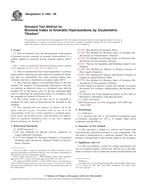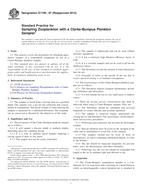1.1 Intent:
1.1.1 This guide establishes the minimum requirements for viewing systems for remotely operated facilities, including hot cells (shielded cells), used for the processing and handling of nuclear and radioactive materials. The intent of this guide is to aid in the design, selection, installation, modification, fabrication, and quality assurance of remote viewing systems to maximize their usefulness and to minimize equipment failures.
1.1.2 It is intended that this guide record the principles and caveats that experience has shown to be essential to the design, fabrication, installation, maintenance, repair, replacement, and, decontamination and decommissioning of remote viewing equipment capable of meeting the stringent demands of operating, dependably and safely, in a hot cell environment where operator visibility is limited due to the radiation exposure hazards.
1.1.3 This guide is intended to apply to methods of remote viewing for nuclear applications but may be applicable to any environment where remote operational viewing is desirable.
1.2 Applicability:
1.2.1 This guide applies to, but is not limited to, radiation hardened and non-radiation hardened cameras (black- and-white and color), lenses, camera housings and positioners, periscopes, through wall/roof viewing, remotely deployable cameras, crane/robot mounted cameras, endoscope cameras, borescopes, video probes, flexible probes, mirrors, lighting, fiber lighting, and support equipment.
1.2.2 This guide is intended to be applicable to equipment used under one or more of the following conditions:
1.2.2.1 The remote operation facility that contains a significant radiation hazard to man or the environment.
1.2.2.2 The facility equipment can neither be accessed directly for purposes of operation or maintenance, nor can the equipment be viewed directly, for example, without shielding viewing windows, periscopes, or a video monitoring system.
1.2.2.3 The facility can be viewed directly but portions of the views are restricted (for example, the back or underside of objects) or where higher magnification or specialized viewing is beneficial.
1.2.3 The remote viewing equipment may be intended for either long-term application (commonly, in excess of several years) or for short-term usage (for example, troubleshooting). Both types of applications are addressed in sections that follow.
1.2.4 This guide is not intended to cover the detailed design and application of remote handling connectors for services (for example, electrical, instrumentation, video, etc.).
1.2.5 The system of units employed in this guide is the metric unit, also known as SI Units, which are commonly used for International Systems, and defined by ASTM/IEEE SI-10, Standard for Use of International System of Units. Some video parameters use traditional units that are not consistent with SI Units but are used widely across the industry. For example, video image format is referred to in “inch” units. (See Table 1.)
1.2.6 Lens and lens element measurements are always in millimeter (mm) units, even where SI Units are not in common usage, as an industry practice. Other SI Units (for example, cm) are rarely used for lenses or lens elements.
1.2.7 Unless otherwise mentioned in this guide radiation exposure refers to gamma energy level in terms of 60Co exposure, and radiation per hour or rad/h refers to instantaneous rate and not cumulative values.
1.3 User Caveats:
1.3.1 This guide does not cover radiation shielding windows used for hot cell viewing. They are covered separately under Guide C 1572.
1.3.2 This guide is not a substitute for applied engineering skills, proven practices and experience. Its purpose is to provide guidance.
1.3.3 The guidance set forth in this guide relating to design of equipment is intended only to inform designers and engineers of these features, conditions, and procedures that have been found necessary or highly desirable to the design, selection, operation and maintenance of reliable remote viewing equipment for the subject service conditions.
1.3.4 The guidance set forth in this guide results from operational experience of conditions, practices, features, lack of features, or lessons learned that were found to be sources of operating or maintenance problems, or causes of failure.
1.3.5 This guide does not supersede federal or state regulations, or codes applicable to equipment under any conditions.
1.4 This standard does not purport to address all of the safety concerns, if any, associated with its use. It is the responsibility of the user of this standard to establish appropriate safety and health practices and determine the applicability of regulatory limitations prior to use.
Product Details
- Published:
- 02/01/2007
- Number of Pages:
- 23
- File Size:
- 1 file , 290 KB


